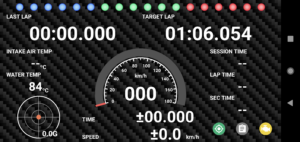Settings menu for acquiring vehicle information (OBD2/CAN) using an OBD2 device.
*This function is available for subscription.
OBD2 device
Use Bluetooth OBD2
Enables the ability to acquire vehicle information using Bluetooth OBD2 devices.
OBD2 device
Select the Bluetooth OBD2 device to be automatically connected.
*The last connected Bluetooth OBD2 device will be automatically set.
Connection
OBD2 protocol
Select the OBD2 protocol for the vehicle to be connected.
*Normally, set to “Auto Detect”.
Device init command
Enter the command (ELM327 AT command) for initializing the OBD2 device.
*This can be set when “User Defined” is specified in the OBD2 protocol.
OBD2 high speed mode
Automatically adjusts the timeout time of the OBD2 device for high-speed communication.
*If communication with the vehicle is unstable, turn this setting OFF.
Fuel consumption data
Acquire fuel consumption related data from OBD2 devices.
*Turning this setting OFF when fuel consumption-related data is not needed will improve the rate at which other data (RPM, etc.) is acquired.
Air/Fuel rate
Acquire air-fuel ratio from the OBD2 device when reception is possible.
*For vehicles equipped with a wideband O2 sensor, turning this setting ON allows for more accurate fuel consumption measurement.
CAN-BUS monitor mode
Monitor vehicle CAN-BUS communications using an OBD2 device.
With compatible vehicle models (or ECUs), more data can be acquired at a higher rate than with OBD2.
Additional menu of CAN-BUS monitor mode
Depending on the car model (or ECU), the following additional menus will appear
CAN silent mode
Communication is performed in silent mode (no acknowledgement is sent).
*Turn OFF if there is no device (dash logger, etc.) other than the ECU and OBD2 adapter that performs CAN-BUS communication.
CAN ID
Specify the ID (in hexadecimal format) of the data to be sent by the vehicle (or ECU).
*Some ECUs can set the ID to be sent. By matching this setting with the ECU side, data can be received correctly.
CAN 1Mbps
Communication with the vehicle (or ECU) is performed at 1 Mbps.
*Some ECUs allow you to set the CAN-BUS communication speed. By matching this setting with the ECU side, data can be received correctly.
CAN extended frame
Communication is performed using CAN extended frames (29bit ID).
*Some ECUs can be set to use either standard frames (11bit ID) or extended frames (29bit ID) for CAN-BUS communication. By matching this setting with the ECU side, data can be received correctly.
Vehicle information
Total weight
Enter the gross vehicle weight (total weight of the vehicle when running including driver, fuel, etc.).
*This is used to calculate the power of the vehicle. If you do not want to display power, this setting is not necessary.
*Enter the weight in kg for metric units or lb for pound units.
Front projected area
Enter the front projected area.
*This is used to calculate the powerof the vehicle. If you do not want to display power, this setting is not necessary.
*Enter in m² for metric units and ft² for pound units.
Drag coefficient(Cd)
Enter the vehicle's drag coefficient (Cd).
*This is used to calculate the power of vehicle. This setting is not necessary if you do not want to display power.
Rev limit
Enter the vehicle's rev limit.
*Use this as the upper limit for the shift lights. This setting is not necessary if the shift lights is not displayed.
Engine displacement
Enter the engine displacement of the vehicle in cm².
*Use this setting when calculating fuel consumption. If fuel consumption is not calculated, this setting is not necessary.
Fuel tank capacity
Enter the fuel tank capacity of the vehicle.
*Use this setting if the remaining fuel level is to be displayed. If you do not want to display the remaining fuel amount, this setting is not necessary.
Functions
Shift lights
Displays the shift lights. The display position is selected from the top, bottom, left, or right edge of the screen.





Shift lights range (lower limit)
Enter the lower limit of engine rpm at which the shift lights will illuminate.
Shift lights colors
Selects the emission color of the shift lights.



Shift lights pattern
When this setting is turned ON, the shift lights emits light from both ends toward the center.
Warnings
Fuel level warning
Sets the fuel level to be displayed as a warning.
*Warning indication (in red) will be shown when the remaining fuel level falls below this setting.
Water temp warning (HIGH)
Enter the water temperature (high temperature) at which the warning is to be displayed.
If the water temperature exceeds this setting, a warning will be displayed (in red).
Water temp warning (LOW)
Enter the water temperature (low temperature) at which the warning is to be displayed.
*When the water temperature falls below this setting, a warning will be displayed (in blue).
Intake Air temp warning (HIGH)
Enter the intake air temperature (high temperature) at which the warning will be displayed.
*If the intake air temperature exceeds this setting, a warning will be displayed (in red).
Intake Air temp warning (LOW)
Enter the intake air temperature (low temperature) at which the warning is to be displayed.
*If the intake air temperature falls below this setting, a warning will be displayed (in blue).
Calibration
Fuel consumption adjustment
Open the Correct Measured Fuel Economy dialog box.

etc
Set to default
Discard all settings in this menu and return to default settings.
